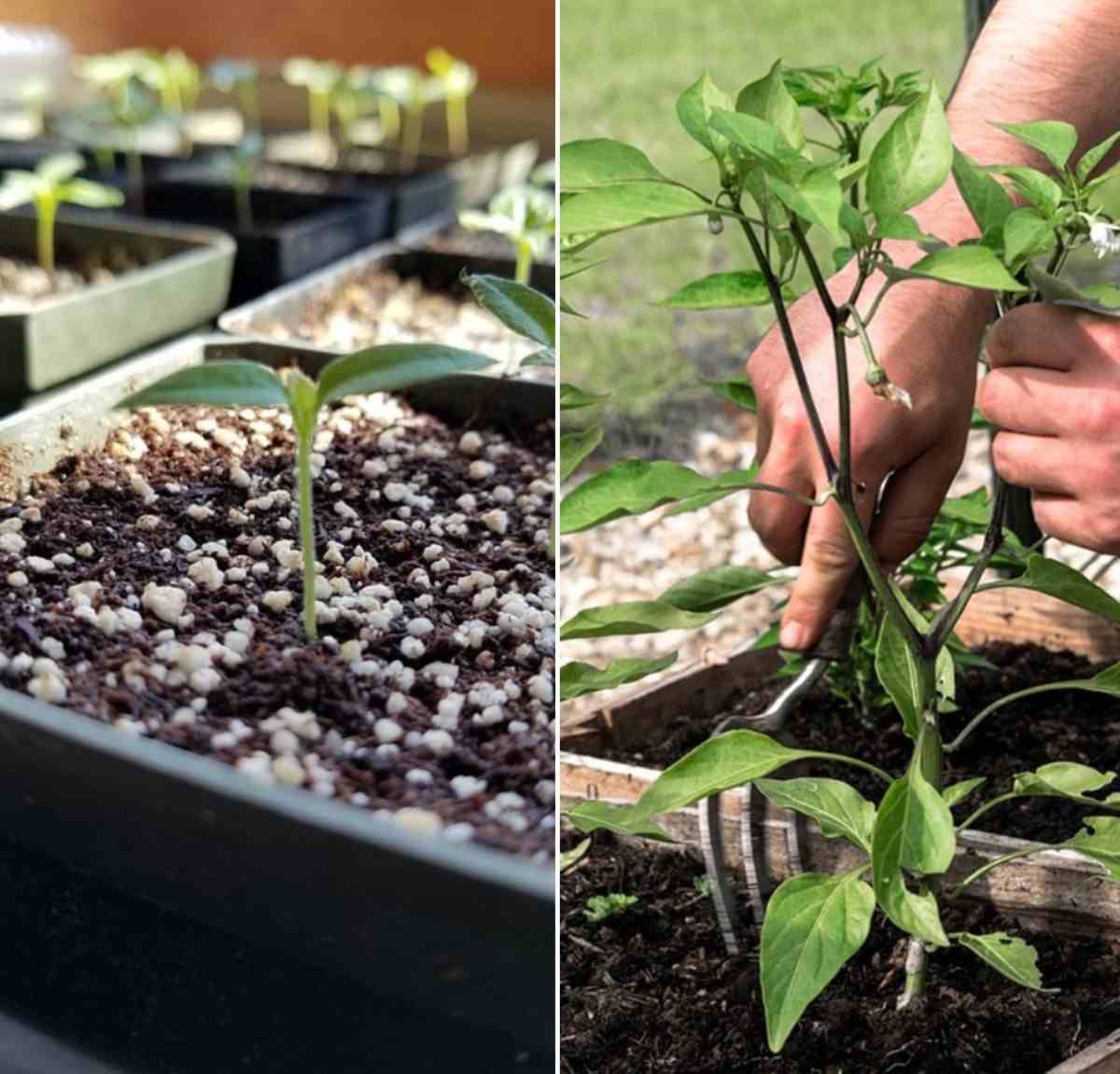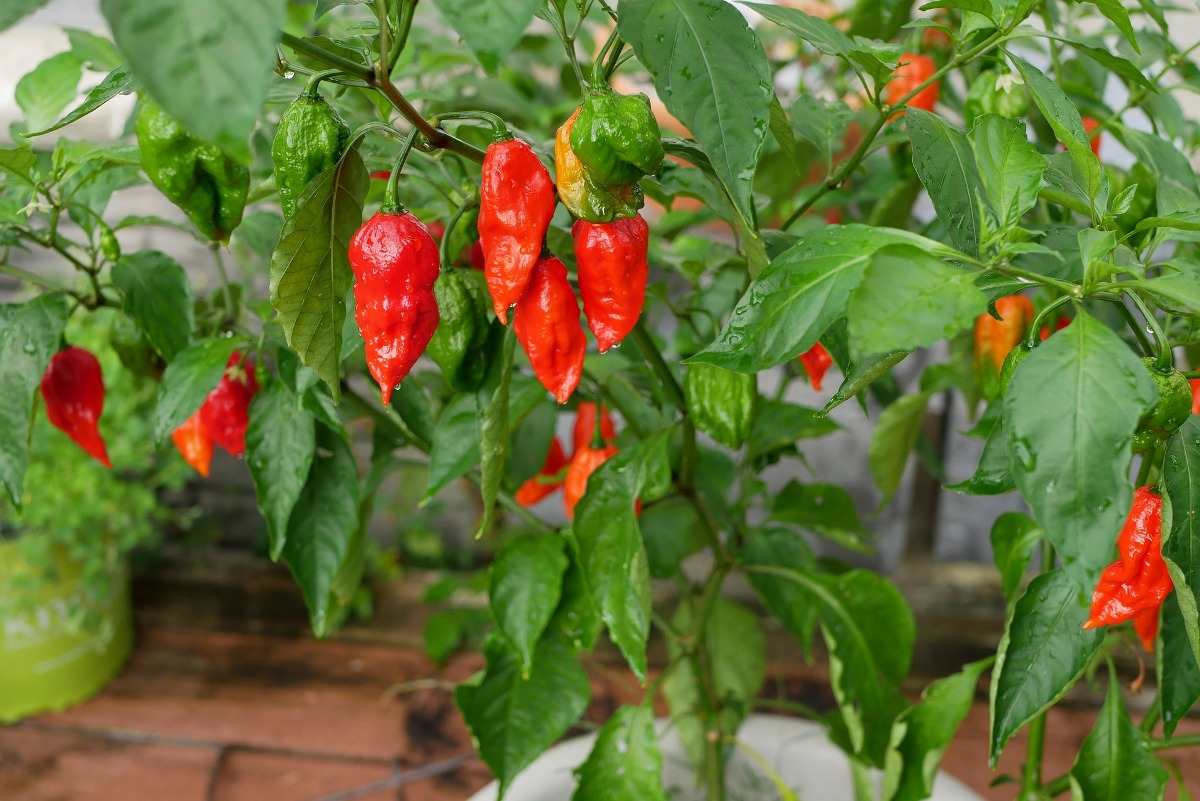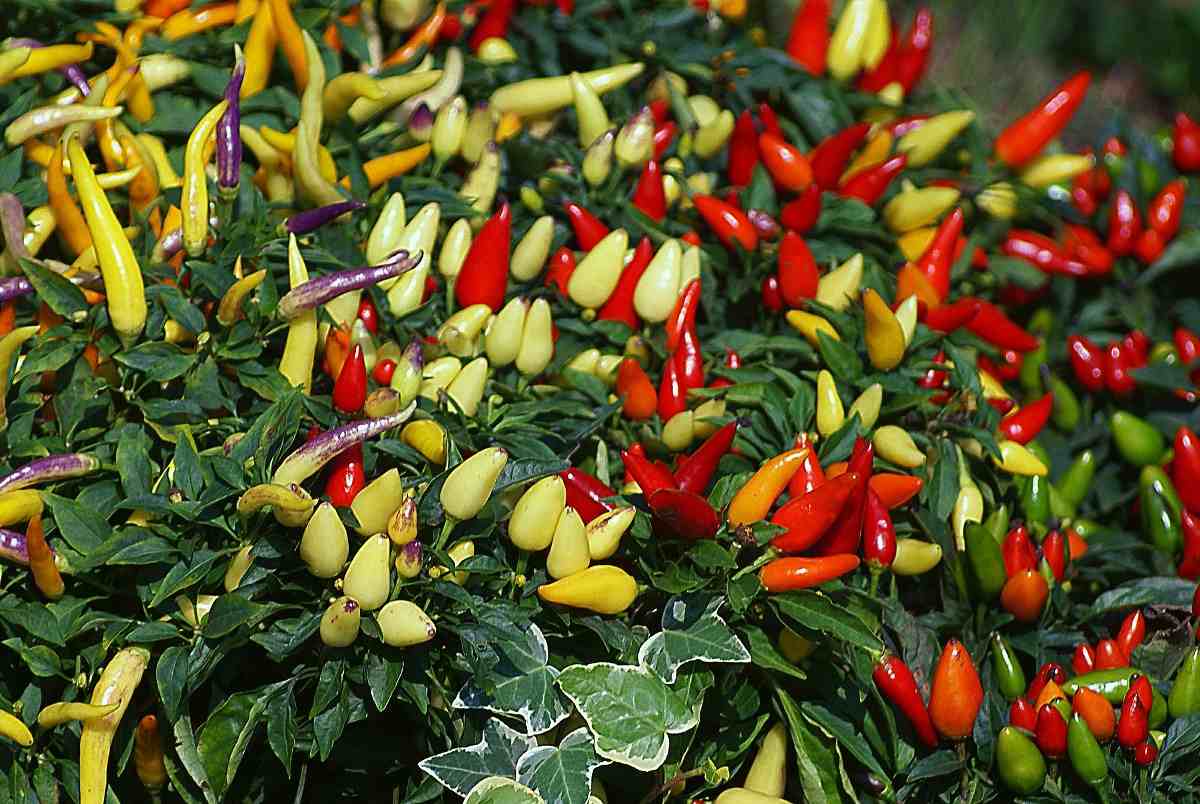Introduction to growing Peppers in pots from seed and cuttings
Peppers are one of the all-time favorite vegetables to grow in pots. Peppers belongs to the Piperaceae family. Here are many different types of Peppers you might want to grow in your garden or even in a container. Depending on tastes and gardening preferences, you may choose to grow mild, hot, sweet, giant, or tiny Peppers. Growing Peppers in pots is a great way to harvest homegrown produce even when you’re short on space. In this article we also discuss below topics;
- How long does Pepper plant take to grow
- How do you grow Pepper plants
- Growing Peppers in containers
- Pepper plant care
- Growing Peppers problems
- Tips for Growing Peppers
- Growing Peppers from seed
- How to make Peppers grow faster
- Growing Peppers from cuttings
- How to clone a Pepper plant
- How to propagate Pepper seeds
A step by step guide to growing Peppers in pots from seed, and cuttings

Select an appropriate container for growing Peppers in pots from seed or cuttings
Purchase a pot with holes in the bottom, or also drill your own to ensure adequate drainage. Use a plastic or metal pot in favor of fast-drying terra cotta, especially because Peppers need consistently moist soil. Planting Pepper in containers requires a pot that is at least 10-12 inches deep and wide and has sufficient drainage holes. You can grow up to 2 to 3 plants (smaller varieties) in such a pot. Small Peppers (less than one foot high) grow well in 2-gallon containers, but bigger plants need at least five-gallon pots. You can grow Peppers in any type of container as long as it’s big enough and also has good drainage. Then, cover drainage holes with mesh to keep soil in and pests out.
Fill your container with organic potting mix
Use a seed starting mix or potting mix for Peppers. Then, they drain much more thoroughly than garden soil, which is key to preventing Peppers from becoming waterlogged. Look for a natural, organic potting mix-they’re particularly formulated for containers with nutrients already added. A good potting mix will hold moisture and provide the roots with aeration and important nutrients.
Pepper plants are susceptible to blossom end rot, a condition where the ends of the Pepper turn black color due to a lack of calcium. Combat this by adding calcium granules to the soil at planting time and then again as the particular brand of calcium you purchase prescribes.
Water and feed the Peppers growing in pots from seed or cuttings
Peppers need consistently moist soil, and container-bound plants generally require more frequent watering than those in the ground. Plan on watering daily, particularly in midsummer. Before watering, and check the soil; you’ll know the plant needs water if the top inch of soil is dry. If it’s not dry, don’t water-you’ll risk overwatering the plant and water early in the morning. Daytime watering evaporates too quickly to give enough benefit, while nighttime watering can leave plants wet for too long and cause them to become waterlogged and harbor bacteria and fungi. A watering can work just fine, and as well a hose with a gentle-setting spray nozzle. Aim for the base of the Pepper plant, not the leaves. Feeding is especially important while the Pepper plants are flowering.
The size of the container or pot and the weather conditions will determine how often you need to water your Pepper plants. We recommend watering plants after the soil has dried somewhat. During the longest hottest days of summer, that can be every day. During cooler weather and spring and fall you may only need to water them every 2 to 3 days. The best bet is to feel the top layer of soil to see if it’s moist, if it is, wait before watering the plant. If it feels very dry, go ahead and give Pepper plant water.
Growing Peppers from seed in pots or containers
You should not miss this: Growing Capsicum Hydroponically.

- Growing Pepper plants from seed require a certain amount of patience. When perfectly stored, Pepper seeds can be viable for up to 25 years, but generally, 2 to 5 years is more realistic for good germination rates. The older the seeds get, the less likely they will sprout and store seeds in a cool, dark, dry environment.
- To germinate, keep Pepper seeds consistently warm and moist, 26-32°C is ideal. Use a seedling heat mat to bring the temperature up, and don’t try germinating Peppers in a cold room or greenhouse as the temperatures can drop which lowers your chance of success.
- Start Peppers indoors 6 to 8 weeks before the last frost date. Peppers like warm weather, so keeping them indoors until it’s warmed up to about 15 to 21°C at night is important. Peppers are very frost sensitive and get stunted in temperature level below 10°C.
- Make sure to let the soil dry out between watering Pepper plants. Make sure to use a well-draining planting mix in pots with plenty of drainages. Pinch off the first few blossoms on Pepper seedlings to encourage them to put their energy into growing stronger roots and foliage, so you’ll have more Peppers later.
- Once sprouted, you can encourage Pepper seedlings to grow stronger, thicker and stockier by simply brushing the seedlings with hands daily, or by adding a fan for a light breeze on the Peppers for a few hours a day. In addition to growing stockier, then this will help prevent dampening off, a common ailment of seedlings that causes them to wither and die after sprouting.
Growing Peppers in pots or containers from seed, and cuttings

Container garden Peppers need two important things they are water and light. These two things will determine where you will grow Peppers in a container. First, your Peppers will need 5 or more hours of direct sunlight. Then, the more light they can get, the better they will grow. Second, the Pepper plant is entirely dependent on you for water, so make sure that your container growing Pepper plant is located somewhere that you will be able to easily get water to it daily. When planting Pepper plant into the container, use organic, rich potting soil; don’t use regular garden soil. Regular garden soil can compact and harm the plant roots while potting soil will stay aerated, giving the roots room to grow well.
You can expect to water Pepper plant in a container at least once a day when the temperature is above 18°C and twice a day when the temperatures rise above 27°C. Pepper plants are self-pollinating, so they don’t need pollinators to help them set fruit, but pollinators can help the plant set more fruit than it normally would. If you’re growing Peppers in planters in a location that can be difficult for bees and other pollinators to get to, like a high balcony or an enclosed porch, you may want to try hand pollinating your Pepper plants. This can be done in two ways. First, give each Pepper plant a gentle shake a few times a day while it is in bloom. This helps the pollen distribute itself to the plant and the other is to use a small paintbrush and swirl it inside each open blossom.
Container garden Pepper plants can be fertilized with compost tea or a slow-release fertilizer once a month. Growing Peppers in containers can be fun and makes these tasty vegetables obtainable to many gardeners who don’t have a traditional, in-the-ground garden.
Growing Peppers from cuttings
While growing Peppers from cuttings is common with ornamental type Peppers, any type of Pepper plant can be used. Choose a stem which is approximately 3 to 5 inches long. The stem must be from a healthy plant with no frost damage, discoloration, or stunted growth. A woody stem will have a better chance of absorbing adequate amounts of moisture to prevent the plant leaves from wilting during the rooting period.
You should not miss this: Lettuce Seed Germination, Period, Temperature, Process.

Select a stem with two or more small branches that will make bushier clones. When rooting Peppers from cuttings, it’s wise to take extra stems in case some don’t root and using a sharp knife or pruning shears, clip the stem at a 45-degree angle. Cut directly beneath one of the small nodes where the plant leaves emerge. The plant tissue in this area is more likely to generate plant roots. Then, remove any Peppers, buds, or flowers. Rooting a Pepper cutting requires the plant to put its energy into making roots, not toward reproduction. Remove the plant leaves from the node that is directly above the cut. If another node sits directly above the first node, remove the plant leaves from that node as well. Dip the bottom of the stem into the rooting hormone.
Use a seedling starter soil, rock wool cubes, and rooting medium such as sand mixed with peat or vermiculite for rooting a Pepper cutting. Gently push the stem into the rooting material. When rooting Peppers from cuttings, it’s necessary to keep the soil or rooting medium consistently moist. Lightly mist or cover the Pepper cuttings with plastic to prevent excessive water loss through the plant leaves. Keep the cuttings at an ambient temperature of 18 to 21°C or on a heated plant mat. Then, provide indirect sunlight or artificial light. It takes approximately 2 weeks for small roots to appear. When the plant roots are about an inch or so (2.5 cm.) long, transplant the root cuttings into a pot. Overwinter the Pepper plants in the house or plant outside if weather conditions permit. Rooting a Pepper cutting is a great way to save and regrow a favorite variety or grow a hybrid variety without saving seeds.
Insects and diseases of Peppers growing in pots from seed or cuttings
Generally, Peppers are problem-free. The same pests and diseases that plague other members of the Nightshade family (tomatoes, potatoes, and eggplants), though, will occasionally attack Peppers. With a few precautions, you can keep Peppers “clean.”
Use organic pesticides to eliminate common pests in Peppers. Destructive caterpillars like cutworms, tomato hornworms, and borers are controlled with Bacillus thuringensis (BT or Thuricide). Rotenone and pyrethrum will readily handle Pepper maggots and weevils, leaf miners, flea beetles, and aphids.
Plant disease-resistant Pepper varieties, particularly if anthracnose, mosaic, and bacterial spot are a problem in your area. Avoid working in the garden after rain and diseases can spread rapidly among wet Pepper plants. Weeds provide a refuge for garden pests and can spread fungi and viruses to nearby healthy plants.
Pepper harvesting
Time to harvest varies and depends on the cultivar you’re growing and conditions, but most of the varieties take 2-4 months. You can identify this when they are ready for their fruit size. The longer you leave chilies on the plant, the hotter if flavor they become, but at the same time leaving them on the Pepper plant after it’s ready for harvest will decline in further fruiting.
Harvesting Peppers requires some finesse, as the delicate branches will break if you tug at them. And use hand pruners, scissors, or a sharp knife to remove the Pepper from the plant. When harvesting Peppers, use gloves or wash hands immediately after picking the fruit. Cut Peppers from the plant by using a pruning shear or knife. Leave a short stub of stem attached to the fruit and do not pull Peppers from the plant by hand; this can result in broken branches.
Commonly asked questions about growing Peppers in pots from seed, and cuttings
In case if you like this: Growing Hydroponic Carrots.

How much time does it take to grow a Pepper?
Most sweet Peppers mature in 60 to 90 days; hot peppers can take up to 150 days. Keep in mind, however, that the number of days to maturity stated on the seed packet refers to the days after transplanting until the Pepper plant produces a full-sized fruit.
Why Pepper seeds won’t germinate?
Failure to seed germinate can be caused by a few things, but most likely it’s because you’re using old seeds that are no longer viable. Too much water or not enough heat is also a common cause.
How many Pepper seeds per hole?
When using new or fresh seeds, you can plant 1 Pepper seed per hole. If you’re using old seeds that have a low viability rate, then plant 2 to 3 per hole. If more than one grows, thin out the weakest once they have 2 to 3 sets of true leaves.
How deep do you plant Pepper seeds?
In general, Pepper seeds should be planted twice as deep as they are wide. So plant your Pepper seeds 1/4 to ½ inches deep.
How many Peppers will one plant produce?
On average, standard bells produce 6 to 8 Peppers per plant.
Why are the leaves on my Pepper plant turning brown?
If leaves are turning brown on Pepper plants, it may be because you forgot to water them. When leaves get brown and crumble, particularly accompanied by the dropping of leaves and drooping of the plant, the plant is likely underwater.
Do Pepper plants need pruning?
Early season plant pruning shouldn’t be done until the plant is at least a foot tall, and can be stopped once the fruit has set. Then, cut back any smaller branches, including any suckers.
Why are my Pepper plants not producing?
Another common reason for a Pepper plant not producing can be to blossom end rot, which is caused by a calcium deficiency and occurs when night temps are over 23°C. Plants with too much nitrogen become lush, green, and large at the expense of Pepper fruit. Peppers need more phosphorus and potassium to set fruit.
Why are my bell Peppers not turning colors?
All bell peppers start green and grow to a mature size before ripening. When a Pepper is fully ripe, it usually turns red color. Peppers naturally ripen slowly, but they’ll take even longer when the Pepper plants aren’t happy. Certain varieties could never turn red at all.
How long does it take green Peppers to turn red?
If your seed packet says it takes 6 weeks for a Pepper to reach maturity, that’s not completely accurate. Peppers can be ready to eat at that time, even though they’re still green. However, it can take 2 or 3 more weeks after maturity for a bell Pepper to turn red.
Why are the leaves on Pepper plants turning yellow?
Pepper leaves are yellow due to a lack of water and nutrients. One of the two most common reasons for yellow leaves on a Pepper plant is under watering or a lack of nutrients in the soil. In both of these cases, Pepper plants will be stunted and will commonly drop the Pepper flowers or fruit.
In case if you are interested in this: Profits in Spirulina Powder Production.